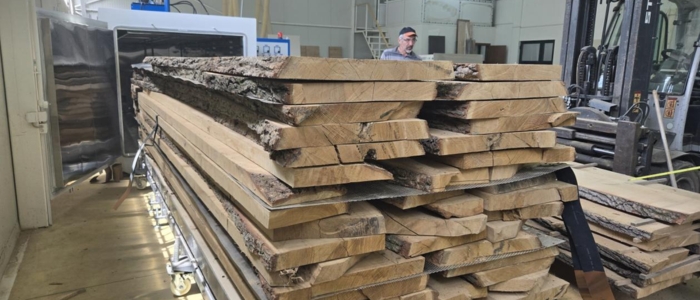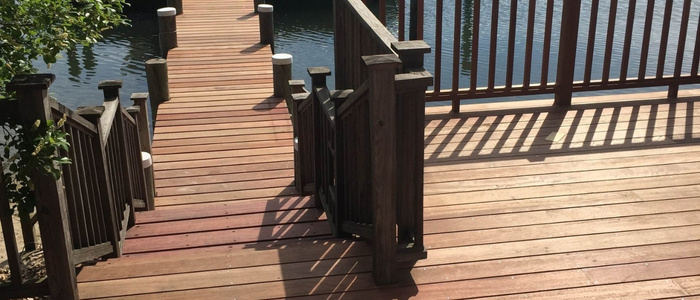What Is the Moisture Content of Kiln-Dried Wood?
Kiln-dried interior hardwood lumber typically has a moisture content of 6–8%. In more humid regions or for general construction you may see 8–10%. The ideal value is the level that matches the equilibrium moisture content (EMC) of the environment where the wood will be used.

Quick Definition
The moisture content (MC) of kiln-dried wood is the percentage of water in the wood relative to its oven-dry mass. Controlled heat, airflow, and humidity reduce green wood (often 30–60% MC or higher) down to a predictable range, commonly 6–8% for climate‑controlled interiors.
Why Moisture Content Matters
Moisture drives wood movement. Lower, uniform MC enhances dimensional stability, improves finish adhesion, prevents fungal growth (most fungi need sustained MC above roughly 20%), increases stiffness below the fiber saturation point (~28–30%), and reduces weight.
Typical Target Ranges by Use
Interior furniture / fine joinery: 6–8%
Cabinetry / millwork (tight tolerance): 6–7%
Musical instruments / precision parts: 5–7%
Hardwood flooring: 6–9% (match site EMC; NWFA alignment)
Interior trim in humid coastal climates: 8–10%
General construction / framing softwood: 12–15%
Exterior projects (exposed): 10–14% pre-install
Note: The “right” answer to what is the moisture content of kiln dried wood or kiln dried lumber depends on the service EMC.
Equilibrium Moisture Content (EMC) Explained
EMC is where wood neither gains nor loses net moisture for given ambient RH and temperature. Approximate indoor RH → EMC:
25–30% RH → 5–6% EMC
35–40% RH → 7–8% EMC
45–50% RH → 8–9% EMC
55–60% RH → 10–11% EMC
If you bring 6% MC lumber into a workshop at 55% RH, it will absorb moisture unless acclimated.
Inside the Kiln Drying Process
Stages: Sorting & stacking; warm-up / equalization; main drying (free then bound water removal); conditioning or steam to relax stresses; final equalization; cooling & controlled storage.
How You Measure Moisture Accurately

A. Pin (resistance) meter
B. Pinless (dielectric) meter
C. Oven-dry method (ASTM D4442) — benchmark / calibration check.
Practical Steps (Pin Meter)
- Set species (or apply correction).
- Record lumber + room temperature (apply temperature correction if needed).
- Drive pins parallel to grain at mid-thickness.
- Take 3–5 readings along each board.
- Sample multiple boards (not just top layer).
- Average stable readings; flag >2% outliers.
- Log date, RH, temperature, species, MC.
Common Errors You Avoid
- Trusting one reading.
- Ignoring species / temperature correction.
- Reading cold boards with surface condensation.
- Only scanning surface when internal gradient exists (case-hardening risk).
Acclimating Your Lumber
Goal: Align delivered MC with target EMC before surfacing, gluing, fastening. Do this:
- Sticker-stack uniformly; elevate off concrete.
- Keep workshop RH similar to service RH.
- Use a data logger for RH/temperature.
- Re-measure daily; start final milling when MC change ≤0.3–0.5% across two consecutive days. Skip acclimation and you risk gaps, cupping, joint failure.
Receiving & Selection Checklist
- Test 5–10% of boards (≥8 pieces small loads).
- Mark MC on board ends.
- Segregate boards if max–min spread >3% (precision work).
- Rip test strip if stress suspected (kerf pinch/open).
- Photograph meter + stack for records.
- Store inside conditioned space promptly.
Choosing Quality Kiln-Dried Lumber (Quick Guide)
- Even color (no gray fungal staining).
- Ends sealed (reduces end checks).
- Minimal case-hardening (test rip behaves neutrally).
- MC variance within tolerance (≤2% for fine joinery; ≤3% general).
- Seller provides drying schedule or at least average + spread data.
- No musty odor (mold risk).
Consequences of Wrong Moisture Content
Shrinkage gaps, swelling bind, cupping, checks, mold, finish adhesion issues, fastener loosening, dimensional instability in precision assemblies.
Factors Influencing Final Moisture Spread
- Species density & anatomy (diffuse vs ring porous).
- Initial green MC (higher start → longer schedule → higher stress risk).
- Kiln schedule aggressiveness (too steep = case-hardening).
- Airflow uniformity & sticker alignment (dead spots create wetter pockets).
- Load thickness mix (mixed thickness complicates equalization).
- Conditioning phase adequacy (insufficient reduces stress relief).
- Post-kiln storage (uncovered transport re-absorbs moisture).
- Regional ambient RH during distribution.
- Packaging (wrap vs bare exposure).
- Handling delays on site (left on truck in rain raises surface MC). Mitigation: Require both average MC and standard deviation / spread before acceptance.
Troubleshooting & Fix Actions
1. Cupping after planing
Action: Measure both faces; if ≥2% difference, restack for balanced airflow.
2. Edge glue joints opening
Action: Current MC lower than assembly MC → premature assembly. Next time wait for stable readings.
3. Flooring squeaks & gaps
Action: Installed above living-season EMC → control seasonal RH; match subfloor MC.
4. Mill burn / fuzzy cuts
Action: Overly dry (<5%) or stressed; allow conditioned rest or recondition.
5. Finish blushing
Action: Surface MC / ambient RH too high; increase airflow, re-sand lightly, refinish.
FAQs
Typically 6–8%; humid regions may use 8–10% to match EMC.
No. It intentionally retains ~5–10% MC to equilibrate without cracking.
Yes through controlled equilibration—store lumber in a chamber or conditioned room set near target EMC (correct RH/temperature) until readings stabilize. Avoid spraying or directly wetting surfaces; that causes gradients and distortion.
Often 3–7 days for 4/4 stock; thicker 1–2 weeks, or until changes ≤0.5% over two days.
Species, initial MC, kiln schedule, airflow, conditioning, storage, regional RH, packaging, on-site handling.
Check average MC + spread, uniform look, no mold odor, minimal stress (rip test), sealed ends, supplier transparency.
For framing softwoods often yes. For fine furniture or flooring, target 6–9% (match EMC).
It keeps exchanging moisture with ambient air until it reaches current EMC.
Heat alone risks surface overdrying; combine modest temperature, controlled RH, and airflow.
Glossary
MC: Moisture Content — percent water based on oven-dry weight.
EMC: Equilibrium Moisture Content at given RH/temperature.
Fiber Saturation Point (FSP): ~28–30% MC; below it shrinkage begins.
Case-Hardening: Residual internal stress pattern causing distortion after machining.
Conditioning: Kiln phase adding controlled humidity to relieve stress and even MC.
Pro Tips You Can Apply Today
- Weigh a test sample periodically; weight loss trend corroborates meter readings.
- Finish both sides of wide panels to reduce uneven exchange.
- Keep a moisture log; repeatability beats guesswork.
- Mark questionable boards with colored chalk for later re-test.
- Pre-calc expected seasonal width change before selecting joinery strategy.
When to Re-Dry, Condition, or Reject
Re-dry: Average MC >2% above target.
Condition: Internal stress shown by kerf closing/opening.
Reject: Active mold, severe stress, excessive checking, unmanageable variance.
Sustainability & Energy Note
Modern dehumidification or heat-recovery kilns reduce energy per board foot and minimize overdrying. Accurate targeting cuts downstream waste from defects.
Key Takeaways Recap
- Typical interior kiln-dried MC: 6–8% (match EMC).
- Verify MC on arrival—don’t rely solely on supplier claims.
- Acclimation bridges delivered MC to service EMC.
- Variation (spread) causes most failures, not one absolute number.
- Treat MC as a design parameter like thickness or species.
Ready to prevent seasonal failures?
Next, calculate expected width movement for your species so you can set proper joinery allowances. Need a sample drying report or moisture log template? Contact us.



